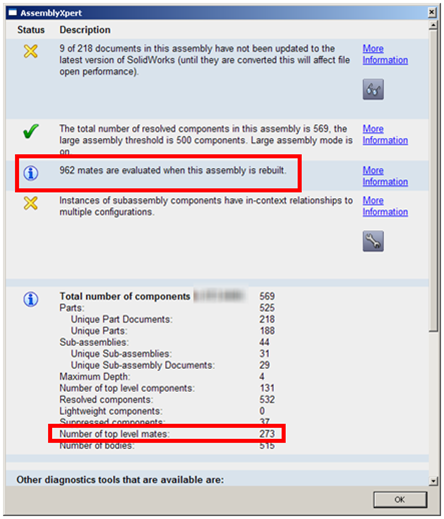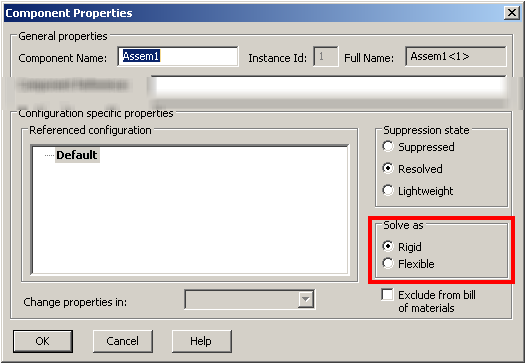Maximizing SOLIDWORKS Performance (MSWP-12-#7)
Reducing Top Level Mates and Solving Subassemblies as Rigid
When an assembly is opened, all of the mates at the top level of the assembly are calculated as well as any mates that are involved in flexible sub-assemblies, you can see this in the AssemblyXpert screen shot below. Solving Subassemblies as Flexible adds a tremendous amount of extra calculations that would not be required if the flexible subs were turned off. In our tests setting our Flexible sub-assemblies to Rigid dropped the number of mates being evaluated at the top level from 962 to 273.
Also when building your assembly you want to make sure that you structured it in a manner to minimize the need for top level mates. To accomplish having less mate in your top level assembly it involves utilizing more sub-assemblies than individual parts and taking advantage of other assembly features such as patterning components like bolts and screws.

If you remember from our first article; our test baseline had a runtime of 5:01:35 and we measured time for the areas of Opens, Rotations, Modeling, Rebuilds, Switching Sheets, Saves and Closes.
After we changed our settings for Add-Ins our macro ran in 4:16:13, this had a noticeable effect in the areas of Opens, Rotations, Modeling, Saves and Closes.
This setting gained us a savings of 0:45:22 or 15.0%.
Please check back to the CATI blog as we will continue posting our series of articles that goes further into the details of each of our tests. All of these articles will be stored in the category of Maximizing SOLIDWORKS Performance and links to each with their release date are listed below:
- Maximize SOLIDWORKS Performance White Paper (7/2/12)
- MSWP-12-#1 Introduction (7/9/12)
- MSWP-12-#2 Windows Visual and User Settings (7/12/12)
- MSWP-12-#3 SOLIDWORKS Options Set to Optimal (7/17/12)
- MSWP-12-#4 Graphics Cards (7/19/12)
- MSWP-12-#5 Turn Off SOLIDWORKS Add-Ins (7/24/12)
- MSWP-12-#6 Processor Clock Speed (7/26/12)
- MSWP-12-#7 Reducing SOLIDWORKS Mates and Rigid Subassemblies (7/31/12)
- MSWP-12-#8 Number of Processor Cores (8/2/12)
- MSWP-12-#9 SOLIDWORKS Graphic Settings (8/7/12)
- MSWP-12-#10 Network Storage and Anti-Virus (8/9/12)
- MSWP-12-#11 Level of Detail (8/14/12)
- MSWP-12-#12 RAM and SWAP File (8/16/12)
- MSWP-12-#13 Hard Drives (8/21/12)
- MSWP-12-#14 Lightweight and Large Assembly Mode (8/23/12)
- MSWP-12-#15 Optimal Configuration and Conclusion (8/28/12)
Thanks,
Josh Altergott, CATI Support Manager
Adrian Fanjoy, CATI Technical Services Director

 Blog
Blog 